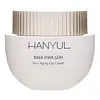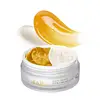What's inside
What's inside
 Key Ingredients
Key Ingredients

 Benefits
Benefits

 Concerns
Concerns

 Ingredients Side-by-side
Ingredients Side-by-side

Water
Skin ConditioningPropanediol
SolventDimethicone
EmollientGlycerin
HumectantPentaerythrityl Tetraethylhexanoate
EmollientOctyldodecanol
EmollientJojoba Esters
EmollientGlyceryl Stearate
EmollientNiacinamide
SmoothingBehenyl Alcohol
EmollientPolyglyceryl-3 Methylglucose Distearate
Emulsifying1,2-Hexanediol
Skin ConditioningCetearyl Alcohol
EmollientPvp
Emulsion StabilisingDipalmitoyl Hydroxyproline
Skin ConditioningPolyacrylate-13
Cnidium Officinale Root Water
MaskingAngelica Acutiloba Root Water
Skin ConditioningButylene Glycol
HumectantPolyisobutene
Stearic Acid
CleansingHydrogenated Lecithin
EmulsifyingPalmitic Acid
EmollientGlyceryl Caprylate
EmollientDisodium EDTA
Ethylhexylglycerin
Skin ConditioningParfum
MaskingPolysorbate 20
EmulsifyingSorbitan Isostearate
EmulsifyingAdenosine
Skin ConditioningDextrin
AbsorbentTheobroma Cacao Extract
Skin ConditioningLentinus Edodes Extract
Skin ConditioningLinalool
PerfumingTocopherol
AntioxidantPhytosphingosine
Skin ConditioningHydrolyzed Ginseng Saponins
Skin ConditioningSodium Polyaspartate
HumectantPanax Ginseng Root Extract
EmollientSodium Methyl Stearoyl Taurate
CleansingAspergillus Ferment
Skin ConditioningWater, Propanediol, Dimethicone, Glycerin, Pentaerythrityl Tetraethylhexanoate, Octyldodecanol, Jojoba Esters, Glyceryl Stearate, Niacinamide, Behenyl Alcohol, Polyglyceryl-3 Methylglucose Distearate, 1,2-Hexanediol, Cetearyl Alcohol, Pvp, Dipalmitoyl Hydroxyproline, Polyacrylate-13, Cnidium Officinale Root Water, Angelica Acutiloba Root Water, Butylene Glycol, Polyisobutene, Stearic Acid, Hydrogenated Lecithin, Palmitic Acid, Glyceryl Caprylate, Disodium EDTA, Ethylhexylglycerin, Parfum, Polysorbate 20, Sorbitan Isostearate, Adenosine, Dextrin, Theobroma Cacao Extract, Lentinus Edodes Extract, Linalool, Tocopherol, Phytosphingosine, Hydrolyzed Ginseng Saponins, Sodium Polyaspartate, Panax Ginseng Root Extract, Sodium Methyl Stearoyl Taurate, Aspergillus Ferment
Water
Skin ConditioningPropanediol
Solvent1,2-Hexanediol
Skin ConditioningGlycerin
HumectantPanthenol
Skin ConditioningLaminaria Japonica Extract
Skin ProtectingEclipta Prostrata Leaf Extract
Skin ConditioningCentella Asiatica Extract
CleansingFicus Carica Fruit Extract
HumectantMelia Azadirachta Leaf Extract
Skin ConditioningMelia Azadirachta Flower Extract
Skin ConditioningCurcuma Longa Root Extract
MaskingAnthemis Nobilis Flower Extract
MaskingAnastatica Hierochuntica Extract
AstringentCalendula Officinalis Flower Extract
MaskingTuber Magnatum Extract
Skin ConditioningMalt Extract
Skin ProtectingOcimum Sanctum Leaf Extract
Skin ConditioningCorallina Officinalis Extract
Skin ConditioningHydrogenated Lecithin
EmulsifyingSodium Hyaluronate
HumectantAcrylates/C10-30 Alkyl Acrylate Crosspolymer
Emulsion StabilisingOctyldodeceth-16
EmulsifyingButylene Glycol
HumectantTromethamine
BufferingDisodium EDTA
Adenosine
Skin ConditioningFructooligosaccharides
HumectantGlyceryl Polymethacrylate
Beta-Glucan
Skin ConditioningSodium Polyacrylate
AbsorbentPvm/Ma Copolymer
Emulsion StabilisingHydrolyzed Hyaluronic Acid
HumectantCeramide NP
Skin ConditioningTocopherol
AntioxidantParfum
MaskingHydrogenated Polydecene
EmollientCaprylic/Capric Triglyceride
MaskingPhenyl Trimethicone
Skin ConditioningBetaine
HumectantPolyglyceryl-3 Methylglucose Distearate
EmulsifyingCyclohexasiloxane
EmollientCetyl Alcohol
EmollientMacadamia Integrifolia Seed Oil
Skin ConditioningPhytosteryl/Isostearyl/Cetyl/Stearyl/Behenyl Dimer Dilinoleate
Skin ConditioningGlyceryl Stearate
EmollientBehenyl Alcohol
EmollientTrehalose
HumectantPentaerythrityl Distearate
EmulsifyingCollagen Extract
Skin ConditioningNelumbo Nucifera Flower Extract
Skin ConditioningRose Extract
Skin ConditioningJasminum Officinale Extract
MaskingNarcissus Pseudo-Narcissus Flower Extract
Skin ConditioningLilium Candidum Bulb Extract
Skin ConditioningIris Versicolor Extract
EmollientFreesia Refracta Extract
Skin ConditioningAnemarrhena Asphodeloides Root Extract
Skin ConditioningOenothera Biennis Oil
EmollientGlycine Soja Oil
EmollientCamellia Japonica Seed Oil
EmollientMacadamia Ternifolia Seed Oil
EmollientHippophae Rhamnoides Fruit Oil
Skin ProtectingPersea Gratissima Oil
Skin ConditioningOlea Europaea Fruit Oil
MaskingHelianthus Annuus Seed Oil
EmollientAmmonium Acryloyldimethyltaurate/Vp Copolymer
Polyglyceryl-10 Laurate
Skin ConditioningSodium Stearoyl Glutamate
CleansingGlucose
HumectantMannose
HumectantButyrospermum Parkii Butter
Skin ConditioningHydrogenated Polyisobutene
EmollientHydroxyacetophenone
AntioxidantEthylhexylglycerin
Skin ConditioningWater, Propanediol, 1,2-Hexanediol, Glycerin, Panthenol, Laminaria Japonica Extract, Eclipta Prostrata Leaf Extract, Centella Asiatica Extract, Ficus Carica Fruit Extract, Melia Azadirachta Leaf Extract, Melia Azadirachta Flower Extract, Curcuma Longa Root Extract, Anthemis Nobilis Flower Extract, Anastatica Hierochuntica Extract, Calendula Officinalis Flower Extract, Tuber Magnatum Extract, Malt Extract, Ocimum Sanctum Leaf Extract, Corallina Officinalis Extract, Hydrogenated Lecithin, Sodium Hyaluronate, Acrylates/C10-30 Alkyl Acrylate Crosspolymer, Octyldodeceth-16, Butylene Glycol, Tromethamine, Disodium EDTA, Adenosine, Fructooligosaccharides, Glyceryl Polymethacrylate, Beta-Glucan, Sodium Polyacrylate, Pvm/Ma Copolymer, Hydrolyzed Hyaluronic Acid, Ceramide NP, Tocopherol, Parfum, Hydrogenated Polydecene, Caprylic/Capric Triglyceride, Phenyl Trimethicone, Betaine, Polyglyceryl-3 Methylglucose Distearate, Cyclohexasiloxane, Cetyl Alcohol, Macadamia Integrifolia Seed Oil, Phytosteryl/Isostearyl/Cetyl/Stearyl/Behenyl Dimer Dilinoleate, Glyceryl Stearate, Behenyl Alcohol, Trehalose, Pentaerythrityl Distearate, Collagen Extract, Nelumbo Nucifera Flower Extract, Rose Extract, Jasminum Officinale Extract, Narcissus Pseudo-Narcissus Flower Extract, Lilium Candidum Bulb Extract, Iris Versicolor Extract, Freesia Refracta Extract, Anemarrhena Asphodeloides Root Extract, Oenothera Biennis Oil, Glycine Soja Oil, Camellia Japonica Seed Oil, Macadamia Ternifolia Seed Oil, Hippophae Rhamnoides Fruit Oil, Persea Gratissima Oil, Olea Europaea Fruit Oil, Helianthus Annuus Seed Oil, Ammonium Acryloyldimethyltaurate/Vp Copolymer, Polyglyceryl-10 Laurate, Sodium Stearoyl Glutamate, Glucose, Mannose, Butyrospermum Parkii Butter, Hydrogenated Polyisobutene, Hydroxyacetophenone, Ethylhexylglycerin
 Reviews
Reviews

Ingredients Explained
These ingredients are found in both products.
Ingredients higher up in an ingredient list are typically present in a larger amount.
1,2-Hexanediol is a synthetic liquid and another multi-functional powerhouse.
It is a:
- Humectant, drawing moisture into the skin
- Emollient, helping to soften skin
- Solvent, dispersing and stabilizing formulas
- Preservative booster, enhancing the antimicrobial activity of other preservatives
Adenosine is in every living organism. It is one of four components in nucleic acids that helps store our DNA.
Adenosine has many benefits when used. These benefits include hydrating the skin, smoothing skin, and reducing wrinkles. Once applied, adenosine increases collagen production. It also helps with improving firmness and tissue repair.
Studies have found adenosine may also help with wound healing.
In skincare products, Adenosine is usually derived from yeast.
Learn more about AdenosineBehenyl Alcohol is a type of fatty alcohol (these are different from the drying, solvent alcohols).
Fatty Alcohols have hydrating properties and are most often used as an emollient or to thicken a product. They are usually derived from natural fats and oils; behenyl alcohol is derived from the fats of vegetable oils.
Emollients help keep your skin soft and hydrated by creating a film that traps moisture in.
In 2000, Behenyl Alcohol was approved by the US as medicine to reduce the duration of cold sores.
Learn more about Behenyl AlcoholButylene Glycol (or BG) is used within cosmetic products for a few different reasons:
Overall, Butylene Glycol is a safe and well-rounded ingredient that works well with other ingredients.
Though this ingredient works well with most skin types, some people with sensitive skin may experience a reaction such as allergic rashes, closed comedones, or itchiness.
Learn more about Butylene GlycolDisodium EDTA plays a role in making products more stable by aiding other preservatives.
It is a chelating agent, meaning it neutralizes metal ions that may be found in a product.
Disodium EDTA is a salt of edetic acid and is found to be safe in cosmetic ingredients.
Learn more about Disodium EDTAEthylhexylglycerin (we can't pronounce this either) is commonly used as a preservative and skin softener. It is derived from glyceryl.
You might see Ethylhexylglycerin often paired with other preservatives such as phenoxyethanol. Ethylhexylglycerin has been found to increase the effectiveness of these other preservatives.
Glycerin is already naturally found in your skin. It helps moisturize and protect your skin.
A study from 2016 found glycerin to be more effective as a humectant than AHAs and hyaluronic acid.
As a humectant, it helps the skin stay hydrated by pulling moisture to your skin. The low molecular weight of glycerin allows it to pull moisture into the deeper layers of your skin.
Hydrated skin improves your skin barrier; Your skin barrier helps protect against irritants and bacteria.
Glycerin has also been found to have antimicrobial and antiviral properties. Due to these properties, glycerin is often used in wound and burn treatments.
In cosmetics, glycerin is usually derived from plants such as soybean or palm. However, it can also be sourced from animals, such as tallow or animal fat.
This ingredient is organic, colorless, odorless, and non-toxic.
Glycerin is the name for this ingredient in American English. British English uses Glycerol/Glycerine.
Learn more about GlycerinGlyceryl Stearate is a mix of glycerin and stearic acid.
It is used to stabilize the mixing of water and oil ingredients. By preventing these ingredients from separating, it can help elongate shelf life. It can also help thicken the product's texture.
As an emollient, it helps soften skin and supports barrier-replenishing ingredients.
In cosmetics, Glyceryl Stearate is often made from vegetable oils or synthetically produced.
This ingredient may not be fungal-acne safe
Fun fact: The human body also creates Glyceryl Stearate naturally.
Learn more about Glyceryl StearateHydrogenated Lecithin is created from the hydrogenation of lecithin (a group of phospholipids). Hydrogenation is a chemical reaction between hydrogen and another element.
This ingredient is an emollient and emulsifier. As an emollient, it helps soften skin by trapping moisture within. As an emulsifier, it prevents oil and water ingredients from separating.
Parfum is a catch-all term for an ingredient or more that is used to give a scent to products.
Also called "fragrance", this ingredient can be a blend of hundreds of chemicals or plant oils. This means every product with "fragrance" or "parfum" in the ingredients list is a different mixture.
For instance, Habanolide is a proprietary trade name for a specific aroma chemical. When used as a fragrance ingredient in cosmetics, most aroma chemicals fall under the broad labeling category of “FRAGRANCE” or “PARFUM” according to EU and US regulations.
The term 'parfum' or 'fragrance' is not regulated in many countries. In many cases, it is up to the brand to define this term.
For instance, many brands choose to label themselves as "fragrance-free" because they are not using synthetic fragrances. However, their products may still contain ingredients such as essential oils that are considered a fragrance by INCI standards.
One example is Calendula flower extract. Calendula is an essential oil that still imparts a scent or 'fragrance'.
Depending on the blend, the ingredients in the mixture can cause allergies and sensitivities on the skin. Some ingredients that are known EU allergens include linalool and citronellol.
Parfum can also be used to mask or cover an unpleasant scent.
The bottom line is: not all fragrances/parfum/ingredients are created equally. If you are worried about fragrances, we recommend taking a closer look at an ingredient. And of course, we always recommend speaking with a professional.
Learn more about ParfumPolyglyceryl-3 Methylglucose Distearate is created from the diester of stearic acid and the condensation product of methylglucose and Polyglycerin-3.
As an emulsifier, it is used to bind ingredients together. Many ingredients, such as oils and water, separate naturally. Emulsifiers prevent them from separating to ensure even consistency in texture.
One of the manufacturer for this ingredient states it is vegetable-based. It is also claimed to be stable at both high and low temperatures.
This ingredient may not be safe for fungal acne. We recommend speaking with a professional if you have any concerns.
Learn more about Polyglyceryl-3 Methylglucose DistearatePropanediol is an all-star ingredient. It softens, hydrates, and smooths the skin.
It’s often used to:
Propanediol is not likely to cause sensitivity and considered safe to use. It is derived from corn or petroleum with a clear color and no scent.
Learn more about PropanediolTocopherol (also known as Vitamin E) is a common antioxidant used to help protect the skin from free-radicals and strengthen the skin barrier. It's also fat soluble - this means our skin is great at absorbing it.
Vitamin E also helps keep your natural skin lipids healthy. Your lipid skin barrier naturally consists of lipids, ceramides, and fatty acids. Vitamin E offers extra protection for your skin’s lipid barrier, keeping your skin healthy and nourished.
Another benefit is a bit of UV protection. Vitamin E helps reduce the damage caused by UVB rays. (It should not replace your sunscreen). Combining it with Vitamin C can decrease sunburned cells and hyperpigmentation after UV exposure.
You might have noticed Vitamin E + C often paired together. This is because it is great at stabilizing Vitamin C. Using the two together helps increase the effectiveness of both ingredients.
There are often claims that Vitamin E can reduce/prevent scarring, but these claims haven't been confirmed by scientific research.
Learn more about TocopherolWater. It's the most common cosmetic ingredient of all. You'll usually see it at the top of ingredient lists, meaning that it makes up the largest part of the product.
So why is it so popular? Water most often acts as a solvent - this means that it helps dissolve other ingredients into the formulation.
You'll also recognize water as that liquid we all need to stay alive. If you see this, drink a glass of water. Stay hydrated!
Learn more about Water